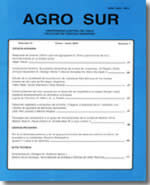Chilean strains of the enthomopathogenic fungus Metarhizium anisopliae var anisopliae discriminated by RAPD markers
Main Article Content
Abstract
Variability of six strains of entomopathogenic fungus Metarhizium anisopliae var anisopliae isolated from Hylamorpha elegans, Phytoloema hermanni, Schizochellus breviventris and Brachysternus prasinus (Coleoptera: Scarabaeidae), Graphognathus leucolomaand Aeghorhinus sp (Coleoptera: Curculionidae) larvae found in soils covered by natural grass-land from three edaphoclimatic areas (the Andes foothills, the central Llano and the coastal dryland) from the 9th Region was studied. The strains were analyzed through random amplified polymorphic DNA (RAPD) technique where 27 random 10-mer primers were found to be able to detect polymorphisms among the strains. The high degree of polymorphism observed suggested a high degree of genetic variation among the six evaluated strains and supported previous reports on M. anisopliae var anisopliae variability.
Complementing the molecular analysis, the strains were also found to differ in conidia morphology, germination and virulence. The conidia mean size of the six strains was 6.0 mm long and 2.2 mm wide, with range of 5.2-7.1 mm and 2.0-2.6 mm, respectively. The strains were also found to differ in colony color and growth pattern.

